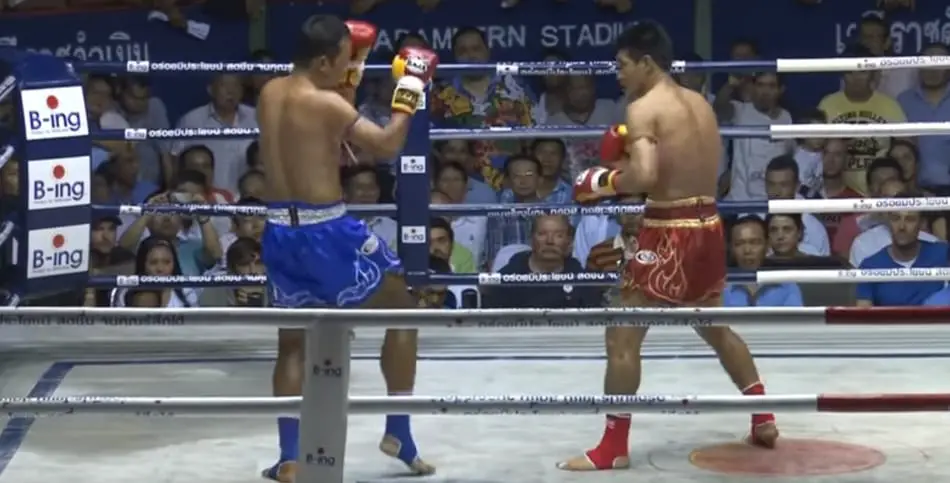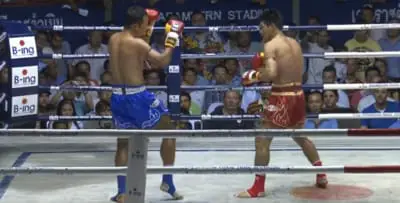
If you watch several Muay Thai fights, you’ll notice that fighters are pretty tall with lean muscle mass. But the question a lot of people ask is how exactly tall are they? That obviously depends on the weight class – the heavier the weight class is, the taller Muay Thai fighters are.
To answer this question, I calculated the average height of the top 10 fighters (according to wbcmuaythai.com) of the most popular weight classes: Super-Heavyweight; Cruiserweight; Supper-Middleweight and Lightweight. So you can get an idea of how tall Muay Thai fighters in different weight classes are.
- Super-Heavyweight (over 230 lbs, 104.5 kg): 6 ft 3 in (190.8 cm)
- Cruiserweight (up to 200 lbs, 90.7 kg): 6 ft 1 in (186.4 cm)
- Super-Middleweight (up to 168 lbs, 76.4 kg): 6 ft (180 cm)
- Lightweight (135 lbs, 61.2 kg): 5 ft 8 in (171.8 cm)
The tallest fighter of those weight classes is the super heavyweight Patrice Quarteron – 6 ft 6” and the shortest fighters are several lightweights standing 5 ft 7”.
I chose those 4 weight classes because the average man weights somewhere in between them (it’s actually 197.9 pounds according to a research of men in the US).
So, as you can see Muay Thai fighters are pretty tall. But if you want to know why exactly is that and what those numbers actually mean, continue reading.
Weight cutting
Keep in mind that to fit in the weight categories, Muay Thai fighters (besides super-heavyweights) often cut weight in the last few days before the fight. They do that by dehydrating themselves by doing a lot of running in special nylon clothing to increase sweating and don’t drink much water or eat food.
They don’t cut as much weight as MMA fighters or wrestlers who can have more than 15% difference in their weight on the weigh-ins and on the fight night.
The average cut for Muay Thai fighters is about 11 pounds (or 5 kilograms). This may seem not that much but it still makes possible for tall and big people to make weight in lighter weight classes.
Another thing I need to mention is that Muay Thai fighters who are in fight camp (preparing for a fight) are in very good shape. They often lose weight (mostly fat) due to the exhausting workouts. That’s important because out of training camp their walk-around weight can be more to 20 pounds heavier.
Kicking-heavy sport
Muay Thai fights often go the distance and judges have to declare the winner. And judges give a lot of points to the fighter that kicks more and more effectively.
And to be able to kick effectively from a far distance, you have to be tall. That’s why Muay Thai fighters and striking martial artists, in general, are usually tall. In boxing, for example, tall people have an advantage because they can jab from a distance where their shorter opponents can’t hit them.
Muay Thai fighters don’t jab as often as boxers but they use their front kick (or teep) the gut/solar plexus as a jab. This is one of the longest and fastest kicks you can throw and in Muay Thai it’s used to keep your opponent at a distance, set up different kicks or punches and score points.
When throwing roundhouse kicks it doesn’t matter how tall you are most of the time. But when it comes to throwing teeps the length of your legs is really important.
Also, it’s easier to throw powerful head kicks to someone shorter than you. Because the taller the person is the higher you need to kick to reach his head and higher the kick travels, the more power it loses. That’s why leg and body kicks are so powerful and that is the reason why short fighters are focusing on those types of kicks.
What other advantages of tall Muay Thai fighters have?
Clinching is a unique aspect of Muay Thai. Besides MMA there aren’t other combat sports where strikes in the clinch are allowed to that extent.
In Muay Thai you can throw punches, elbows, and knees to the head and the body as of your opponent. You can also do leg sweeps and trips to take your opponent down.
In clinching height is also a factor. When you are taller than your opponent it’s much easier to establish a good Muay Thai clinch position – both your hands on the back of the head of the opponent (your arms are inside of his arms), pulling his head down.
While short fighters have to reach up to grab the head of their opponents, tall fighters have a much easier time doing that because their shoulders are about the same level as the head of someone shorter.
Tall fighters are also generally more dangerous in the clinch. Their knees can reach the head of someone shorter much easier and their elbows are more powerful. The longer your arms are the more leverage you have when throwing elbow strikes.
In wrestling, for example, short wrestlers have an advantage because they have an easier time changing levels and grabbing the legs to take their opponent down. But in Muay Thai grabbing the legs to perform a takedown isn’t allowed which favors tall fighters in the clinch.
After you establish control of the head of the opponent in the clinch you are pretty much safe. That’s why clinching is often the tall Muay Thai fighters the go-to in case they are hurt or just want to stall the fight.
Advantages that short Muay Thai fighters have
Muay Thai can be tough when fighting someone with significant height and reach advantage. As we discussed, generally tall fighters have an advantage both on the outside range (long boxing and kicking range) and in very close range (clinching). So how can you beat somebody that has the advantage in both very far and very close ranges?
Now before answering this question, I think it’s important to mention that I’m talking about situations where both fighters are on the same skill level. If the shorter fighter is significantly more skilled than his taller and longer opponent he’ll beat him no matter where in the clinch or on the outside range, mid-range or inside boxing range.
Usually, short fighters have more power than their taller opponents in the same category. One of the reasons for that is because they have more muscle mass. Tall guys need to cut more weight so they often are skinnier.
In order to win, short Muay Thai fighters need to use their power advantage. They need to make the fight a sort of a brawl instead of a rangy technical bout. Pressure and keeping a mid-boxing range is the key.
Tall fighters may have an advantage on the outside and in clinching range but in mid to close boxing range, they don’t really have enough space to punch with power and they are not close enough to throw elbows safely.
Now, this may vary from fighter to fighter, for example, there may be a tall Muay Thai fighter or boxer who have sick close range hooks and overhands. But in most cases, short fighters are more powerful when throwing looping punches and roundhouse kicks.
The problem is that it’s very hard to keep this middle ground all the time – not too far nor too close. Also, it’s generally easier to keep your opponent at a distance rather than closing the distance. There are a lot of tricks short fighters know to close the gap but most of the time you have to be ready to take a shot before getting close enough to land your own shots.
Everybody who sparred with someone significantly taller knows that. If you are too hesitant and don’t want to risk, he/she will just pick you apart from a distance.



